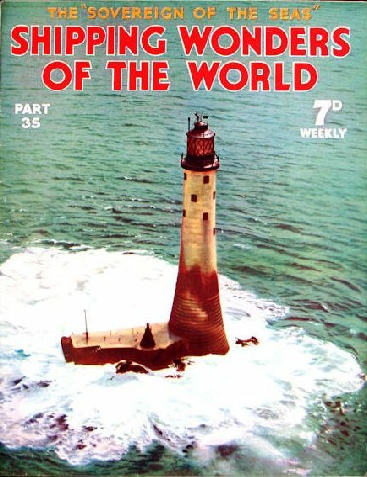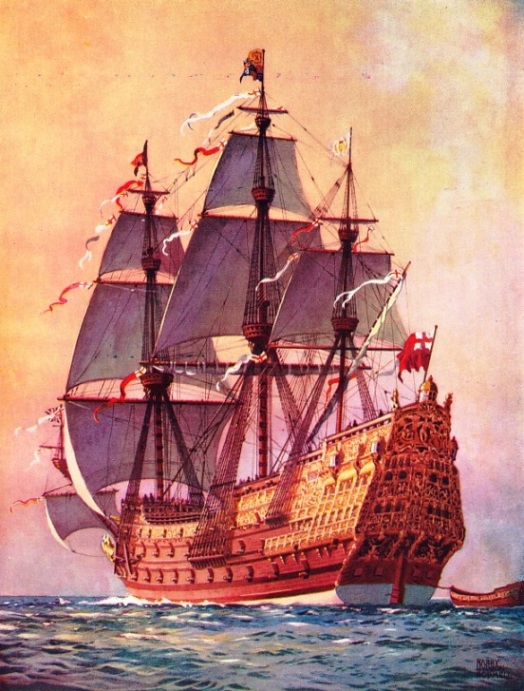
© Shipping Wonders of the World 2012-



Part 35
Part 35 of Shipping Wonders of the World was published on Tuesday 6th October 1936.
This issue included a colour plate illustrating the Sovereign of the Seas, which formed part of an article on this ship.
The Cover
“The subject of the cover this week is rather unusual. It shows the Wolf Lighthouse, off Land’s End, Cornwall. The lighthouse stands on a rock and its 70 candle-power light is 110 feet high. The light shows alternate red and white flashes, lasting two seconds, and is visible for a distance of sixteen miles. The work of Trinity House is an amazing example of efficiency. Trinity House is responsible for the safety of shipping round the often dangerous coasts of Great Britain, and this great task is shouldered with remarkable success. The wonders of the modern lighthouse are not, perhaps, revealed as much as they should be, but readers will remember that the chapter called Signposts of the Sea gives an insight into the story of these important aids to navigation.”

Contents of Part 35
The Adventures of Captain Voss
The story of the voyages of Captain Voss, concluded from part 34.
Marine Models
Miniature representations of ships attract their enthusiasts all over the world. Ship models may be ornamental (“glass-case”) or working models, and their purpose may be to give pleasure to the amateur, to advertise a shipping line, or to further research in naval architecture. This chapter complements the article on “Ships in Miniature” which appeared in an earlier part.
Russian Shipping
In a remarkably short time the Soviet Union has built up a considerable mercantile marine with the object of handling all Russia’s overseas trade in Soviet ships. Unparalleled measures have been taken to achieve this end with efficiency.
This chapter is the eighth article in the series on Sea Transport of the Nations.
The Secret of the Niger
The conquest of the River Niger was effected only after many years of exploration, hardship and tragedy in the face of almost insuperable dangers.
This chapter is the twelfth article in the series on World Waterways.
The Sovereign of the Seas
Next to the Victory, perhaps the most famous of the “wooden walls of England” was the Sovereign of the Seas, later the Sovereign and finally the Royal Sovereign. It was King Charles I who conceived the idea of building the mightiest ship that had yet been seen, and he drew up the first plans for her. This chapter describes the eventful history of this famous ship, with details of her dimensions and armament.
The Sovereign of the Seas (colour plate)
Contents of Part 35 (continued)
Danish Standard Motor Tramp
A description of the Bornholm, a vessel of the long bridge type, with a short forecastle, long central bridge structure and short poop. The Bornholm is owned by the Dansk-Franske Company and was completed in Copenhagen in June 1930.
This is the twenty-seventh article in the series on Merchant Ship Types.
Gunboat Patrols in China
The Royal Navy may be on active service in peace-time. That is a fair description of the duties of the China Gunboats, about which this chapter is devoted. The Yangtse Gunboat Patrol is a section of the Royal Navy which is always on active service. Over a stretch of 1,300 miles of river these interesting units protect civilians of every nationality from the attentions of numerous bands of pirates.
This chapter is the ninth article in the series The Navy Goes to Work.
There is a complementary article on Chinese Piracy.
Epic of the Motor Launches
The Motor Launch Patrol included 550 MLs manned by officers and men of the Royal Naval Volunteer Reserve. In the successful raids on Ostend and Zeebrugge the dramatic exploits of the MLs gained for these small craft a permanent place in naval history. This chapter is concluded in part 36.
The Sovereign of the Seas
THE FINEST MAN-OF-WAR OF HER TIME, the Sovereign of the Seas marked an important stage in the development of naval architecture. She was designed by Phineas Pett. On September 25, 1637, King Charles I was present at the launching ceremony at Woolwich. She stuck on the slipway, however, and was not launched until some weeks later. The total cost of the ship was £40,833 8s 1½d, of which £6,691 were spent on her extravagant decoration. Her stern towered to a tremendous height and made her unsuitable for service at sea until 1652 when Cromwell had her reduced to a two-decker. Cromwell had her renamed Sovereign. Popular demand refused to allow the Puritans to deface her gilded decorations. Her yellow hull and gilded ornament therefore made her conspicuous in naval engagements with the Dutch, who gave her the nickname of the “Golden Devil”. At the Restoration in 1660 she was renamed the Royal Sovereign and in subsequent actions set a noble example to the successors to her name. On January 29, 1696, through a watchman’s negligence, the famous ship caught fire in what is still called the Sovereign reach of the River Medway, at Chatham. She was completely destroyed.
